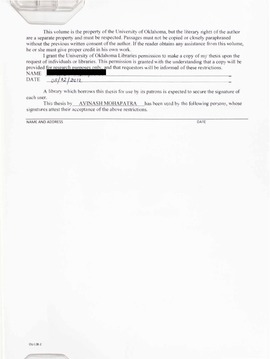| dc.contributor.advisor | Rai, Chandra S. | |
| dc.contributor.author | Mohapatra, Avinash | |
| dc.date.accessioned | 2017-08-28T16:20:42Z | |
| dc.date.available | 2017-08-28T16:20:42Z | |
| dc.date.issued | 2012 | |
| dc.identifier.uri | https://hdl.handle.net/11244/51925 | |
| dc.description.abstract | Surface seismic offers a promising technique to monitor CO₂ flood fronts during enhanced oil recovery process. Changes in seismic signature have been observed with CO₂ flooding but quantification of the seismic signature with respect to subsurface saturation is still in its infancy. The model currently used in industries for fluid quantification are either non-linear or inappropriately describe the rock-fluid system undergoing CO₂ flooding. This study is focused on quantification of the variation in seismic parameters (velocity and impedance) with the change in subsurface fluid type and saturation. | |
| dc.description.abstract | In order to achieve this objective, velocity equilibration study is performed to understand the time required for liquid CO₂ to equilibrate in pores. This is followed by experiments to observe the influence of effective pressure on velocity. The outcomes of the above experiments determined some of the parameters for flooding experiments. The results of the flooding experiments are presented where velocity and density were monitored as the pore fluids (formation brine and oil, and CO₂) are replaced sequentially. All the experiments were performed at in-situ pressure conditions on plugs (Tuscaloosa sandstones) recovered from a well in a field currently undergoing CO₂ flooding. The plugs used are characterized as fluvial (quartz~87% , clay~ 10%) and distributary channels (quartz ~ 75%, clay~ 17% ). | |
| dc.description.abstract | During brine flooding on dry samples, a decrease m P-wave velocity (~2%) was observed till 95% saturation and thereafter the velocity increases by 15% during the remaining 5% saturation. After attaining 100% brine saturation, oil was pumped to displace brine till irreducible water saturation was achieved. A linear drop of 4% in velocity was observed during this step. Liquid CO₂ was injected to displace oil-brine system and a drop of 8% in P- velocity was observed. Associated changes in P-wave impedance due to change in pore fluid saturation were observed to be 25%, -5% and - 8% respectively for the three flooding experiment. Biot-Gassmann modeling showed good agreement with experimental results for gas-brine and oil-brine system but not for liquid CO₂ flooding. However, the CO₂ flooding experimental data validated patchy model. Apart from patchy model, an empirical correlation is developed that can be used directly to convert seismically interpreted pre and post flooded impedance data to CO₂ saturation. | |
| dc.description.abstract | Using the patchy model and empirical correlation, the fluid substitution on field pre-flooded logs quantified the CO₂ saturation. Based on the pre flooded base and empirically CO₂ substituted logs, a synthetic seismic difference was generated as a function of CO₂ saturation to study the 4D seismic signature and A VO response to CO₂ saturation. | |
| dc.format | xviii, 107 leaves : ill. (chiefly col.), col. maps ; 29 cm.. | |
| dc.language | en_US | |
| dc.subject | Enhanced oil recovery | |
| dc.subject | Oil field flooding | |
| dc.subject | Secondary recovery of oil | |
| dc.subject | Seismic waves | |
| dc.title | Seismic signature of sedimentary rocks with CO₂ flooding | |
| dc.type | Thesis | |
| dc.type | text | |
| dc.contributor.committeeMember | Sondergeld, Carl H. | |
| dc.contributor.committeeMember | Devegowda, Deepak | |
| dc.date.manuscript | 2012 | |
| dc.thesis.degree | Master of Science | |
| dc.note | Includes bibliographical references (leaves 93-101). | |
| ou.group | Mewbourne College of Earth and Energy::Mewbourne School of Petroleum and Geological Engineering | |
